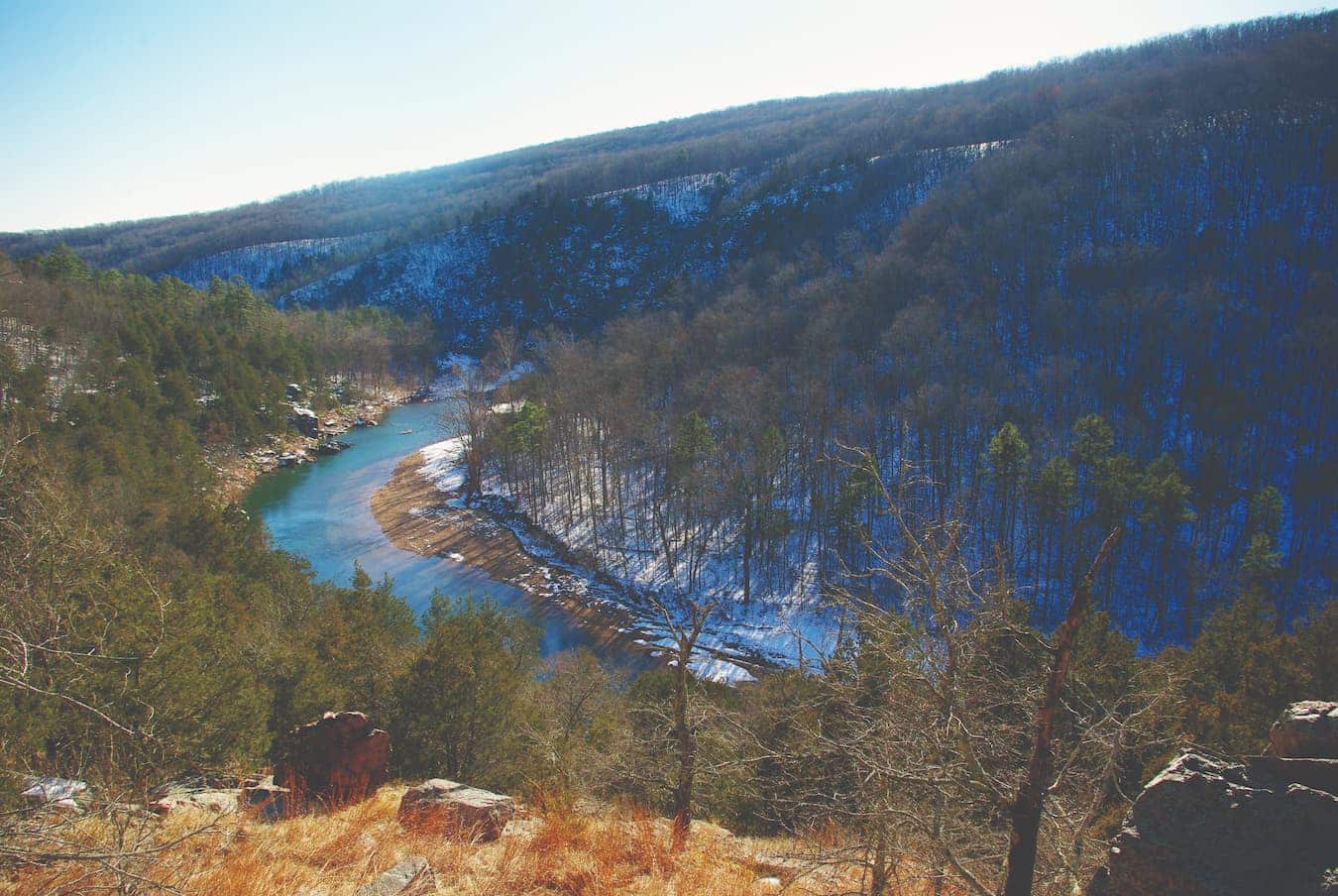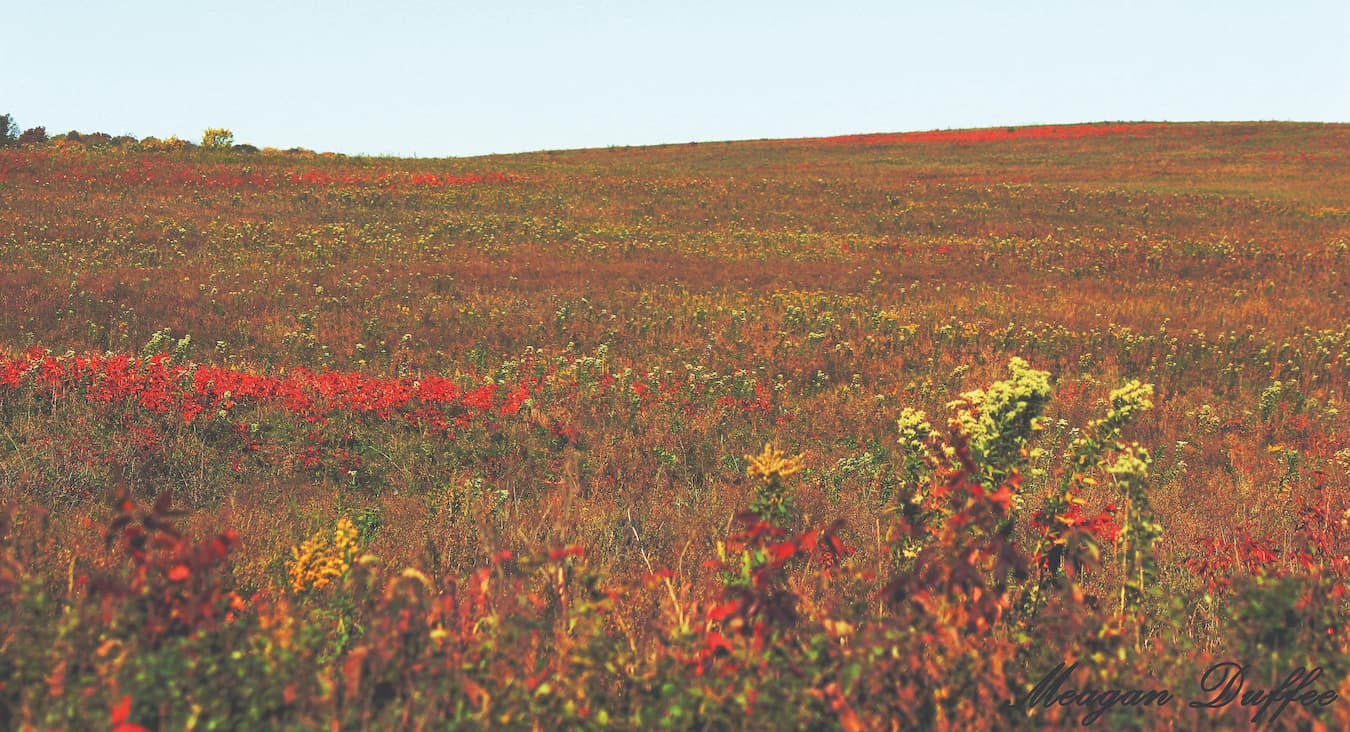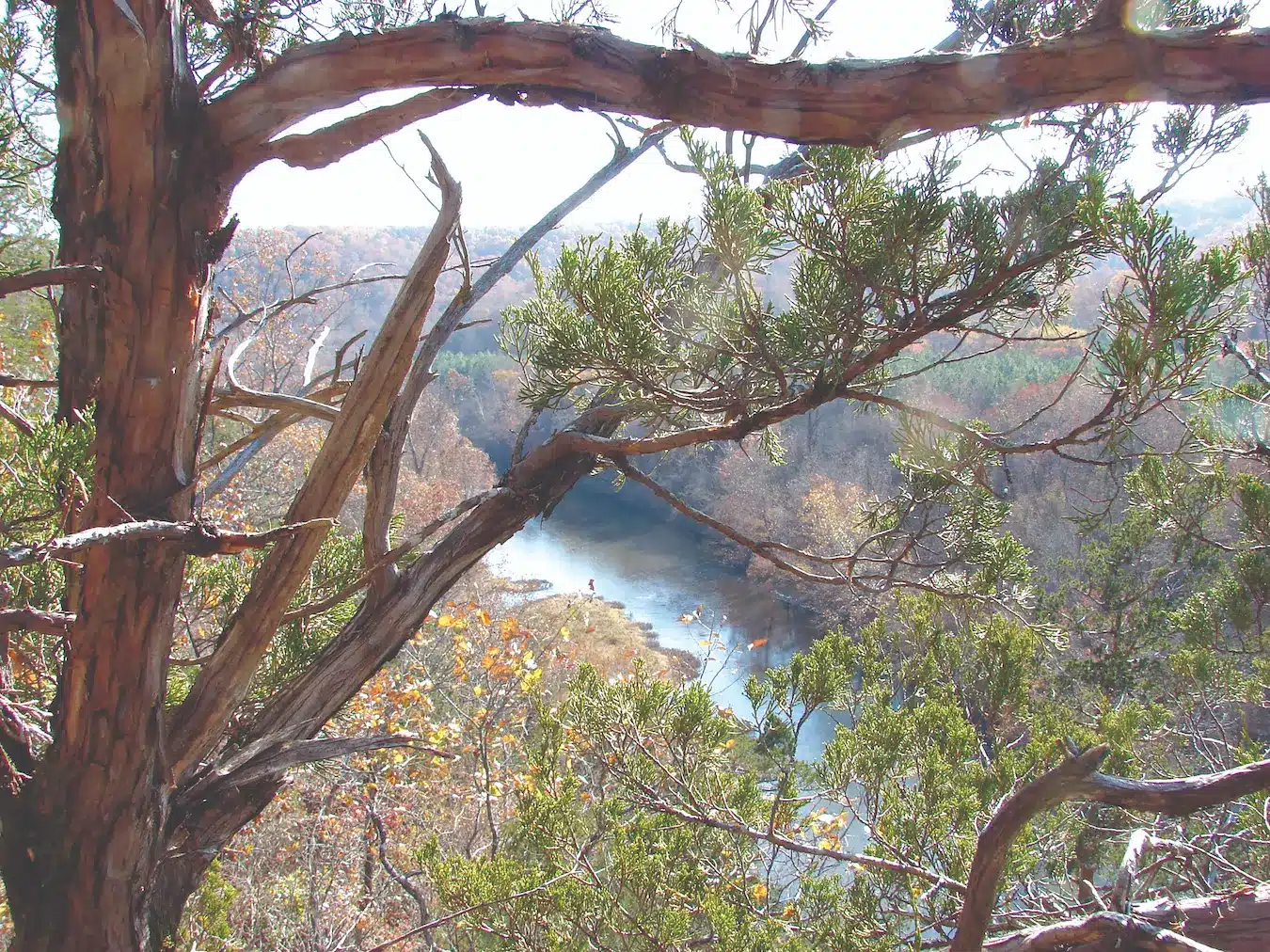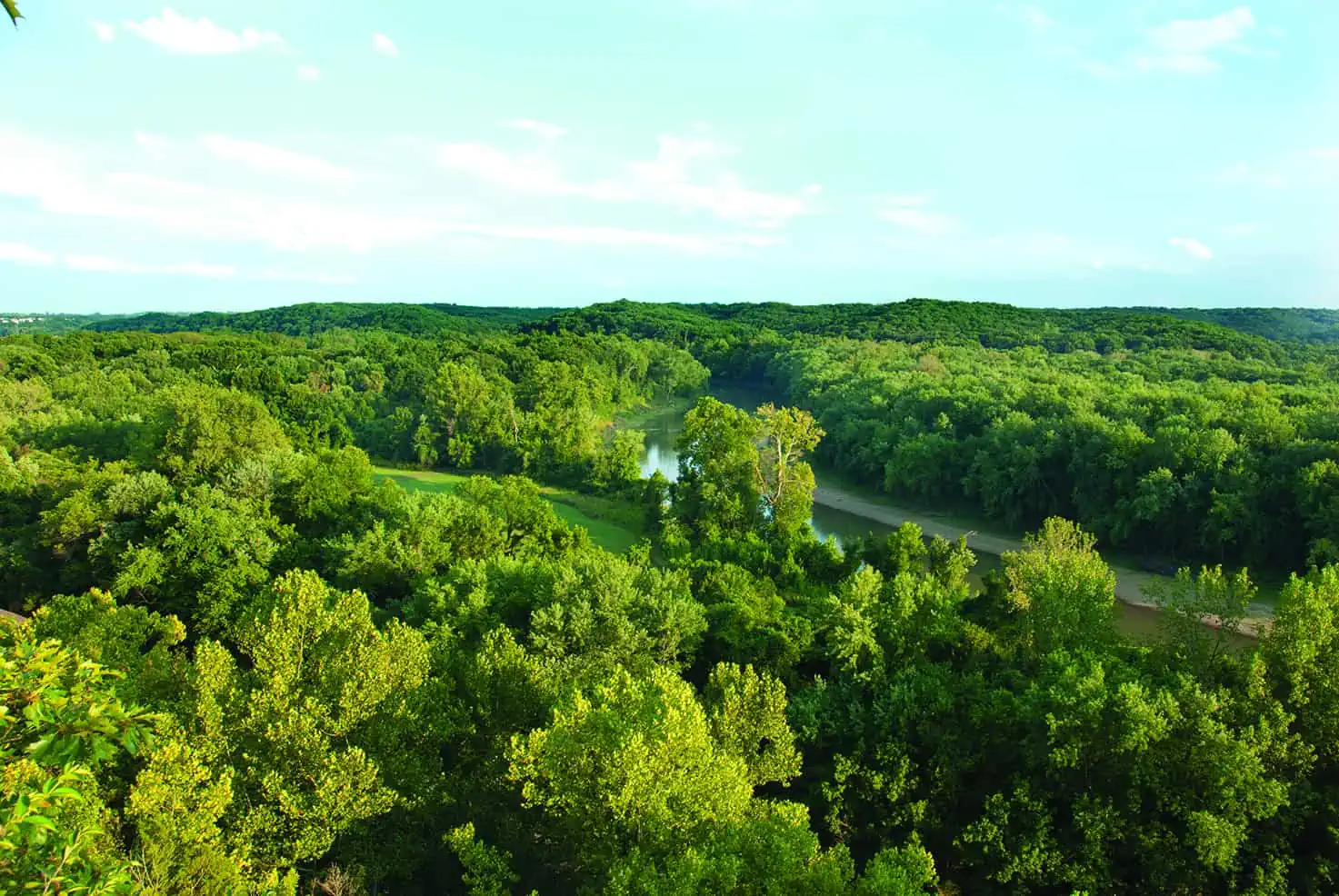A favorite of conservationists and Scouts, this hilly hideaway in the St. Francois Mountains features a number of special superlatives: highest mountain peak and tallest waterfall in Missouri, and one of the rarest plants in the United States.
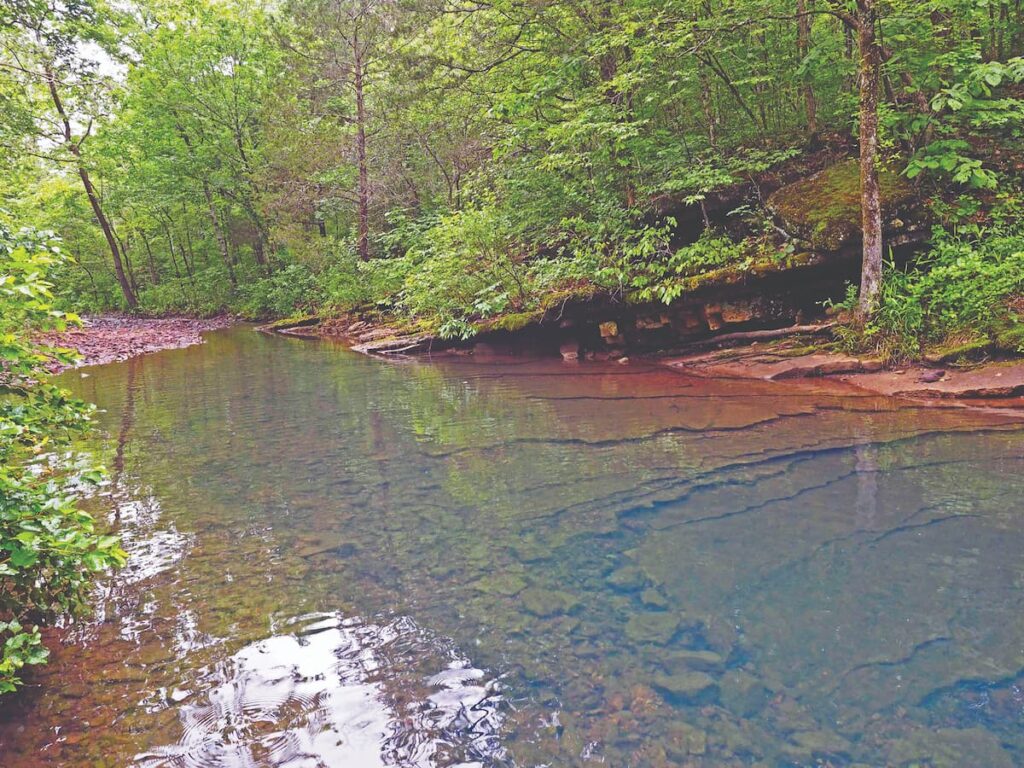
Photo by Mike Sutton
The geologic phoenix of the Ozarks, Taum Sauk Mountain was born of volcanic fire 1.5 billion years ago, then rose eons later at the very center of the Ozark dome. If Elephant Rocks is where one goes into the core of the Ozarks amid the pink granite boulders, Taum Sauk is where one ascends to the apex of the Ozark dome and surveys the world around. Located at the center of the 5,000-square-mile St. Francois Mountains with thirty nearby summits, Taum Sauk—likely a reference to the Sauk tribe, possibly meaning Big Sauk—is the state’s highest point at 1,772 feet above sea level. Nowhere else in Missouri does such a panorama of nature’s wild treasures and earthly forces combine.
Some forty local landowners willingly agreed to part with their properties spanning Iron and Reynolds Counties for the 8,730-acre Taum Sauk Mountain State Park beginning in 1990. The area had been recommended for acquisition as a national forest or state park as early as 1914. Then in the 1940s, Missouri writer and conservationist Leonard Hall proposed a 60,000-acre roadless wilderness preserve in the St. Francois Mountains, in a grand arc from Bell and Lindsay Mountains in the north through Goggins on the west to Taum Sauk and on, but the plan faltered owing to multiple ownerships. Interest in the area became even more widespread after 1958, when the twenty-eight-mile Taum Sauk Boy Scout Trail was dedicated; it stretches from Elephant Rocks in the north to Taum Sauk Mountain, and on west to Johnson’s Shut-Ins State Park, which was new at the time. Since 1958, tens of thousands of Scouts and numerous other hikers have taken the trail. For the hardy, hiking the fourteen miles from Taum Sauk Mountain to Johnson’s Shut-Ins is the best way to take the measure of the park and of yourself.

Photo by Paul Nelson
The drive to the mountain is not direct, no matter from which quarter of the state you begin, and therein lies a geography lesson. You will negotiate frequent hills and curves as the highway threads through the forest, with only the rare elevated ridge cleared of trees providing an overlook of the river valleys. When you can see out, you note a distant horizon made uniformly flat by the succession of deeply dissected ridges and valleys mingled into one. This is the great geologic dome of the Ozark interior, its ancient ocean-deposited limestones, shales, and sandstones lifted upward only to be deeply incised by spring-fed rivers and streams. If you can imagine the valleys and hollows filled with rock and grit until they were level with each successive ridge, a tabletop landscape would result—the Ozark plateau. But the fill has long since been removed by hundreds of millions of years of ceaseless erosion, creating today’s rugged landscape.
As you approach closer to Taum Sauk Mountain from any direction, you begin to see distinctly elevated knobs in the distance: these are the St. Francois Mountains, the time-gentled igneous remains of ancient volcanoes here at the geologic core of the Ozarks. As your car ascends the mountain flank, every break in the trees reveals the massiveness of the broad, rounded summits. Just before the road curves into the parking area in Taum Sauk Mountain State Park, there is an overlook above Arcadia Valley to the north with numerous St. Francois knobs in view and an exhibit identifying them. At the parking area at the trailhead, you jump out, eager to stretch your legs and explore this vastness afoot.
A short spur off the popular Mina Sauk Falls Trail takes you up to Missouri’s highest point. At the summit, the mountain is flat. While its height is not sufficient to demonstrate life zones at different elevations, its height above the surrounding Ozark plateau teases the atmosphere enough to show subtle climatic differences. While the summer temperature on top of the mountain often reaches ninety degrees Fahrenheit, winter’s weather is like that of Kirksville in northeastern Missouri, and local residents may witness the mountaintops capped in snow. All around, tree limbs lie scattered about the mountain crest, having shattered under the weight of frequent ice storms. Nearly every tree shows the influence of wind and ice breakage and the scars of lightning strikes.
Then, take the three-mile-loop trail to the falls, which gradually descends the mountain’s west flank onto successive glades of exposed igneous rock, here and there dotted by dwarfed trees and grasses resulting from the shallow, droughty soils. Smoke and Church mountains loom through the veil of a low cloud cap south of the Taum Sauk Creek valley. To the north are Wildcat Mountain and Weimer Hill, and in the distance, the northeast-trending arc of Proffit Mountain, their level summits falling just a little short of the highest point on Taum Sauk. This is one of relatively few vantage points from which one can see a portion of the unnatural high white wall of Ameren’s Taum Sauk hydroelectric storage reservoir—located not on its namesake mountain but at the southern end of Proffit Mountain. Your attention may be pleasantly diverted by a pair of turkey vultures riding fixed on an invisible wave of mountain air.
After about four hundred feet of progressively steeper descent from the top of Taum Sauk, a timeless roar signals that Mina Sauk Falls is near. At the crest of the falls, rainwater collects in a small stream before plunging down a series of volcanic rock ledges positioned at right angles across ancient faults and rock fractures. The total drop of the falls is 132 feet, making this Missouri’s tallest waterfall. This wind-swept, pine crowned cascade stands sentinel above the Taum Sauk valley. Here, you can gaze with wonder at the massive knobs on each side of the deep valley below. The pink-layered rock underlying the falls is ash that spewed forth from some ancient volcano more than a billion years ago.
At the top of the falls, the Taum Sauk section of the Ozark Trail, following parts of the old Boy Scout Trail, comes down the southwest slope of the mountain into Taum Sauk Creek valley. You have a choice—best made before you start—whether to continue looping back up the mountain to your car on the Mina Sauk Trail or to follow the Ozark Trail down to the valley below and across Proffit Mountain to Johnson’s Shut-ins. Only the hardy and well prepared should go all the way to the shut-ins, but if you do, you will be richly rewarded with indelibly imprinted memories of vistas and natural features.
Taum Sauk Creek valley is Missouri’s deepest valley, measuring one thousand feet from the mountain summit to the mouth of the creek on the East Fork Black River some seven miles southwest. The upper five-and-a-half miles of the creek within the mountain fastness—so remote and unsuited to agriculture that the area was never settled—has been designated an Outstanding State Resource Water. Its waters are crystal clear, and it retains nearly all of its biotic integrity. Ozark witch hazel, a shrub that brings forth its sweet-scented red and yellow blossoms as early as January, lines its banks. Shortly after reaching the creek at the base of the falls, the trail passes through Devil’s Tollgate, an eight-foot wide gap in a mass of pink igneous rhyolite some thirty feet high and fifty feet long. Not surprisingly, this is a popular lunch spot.
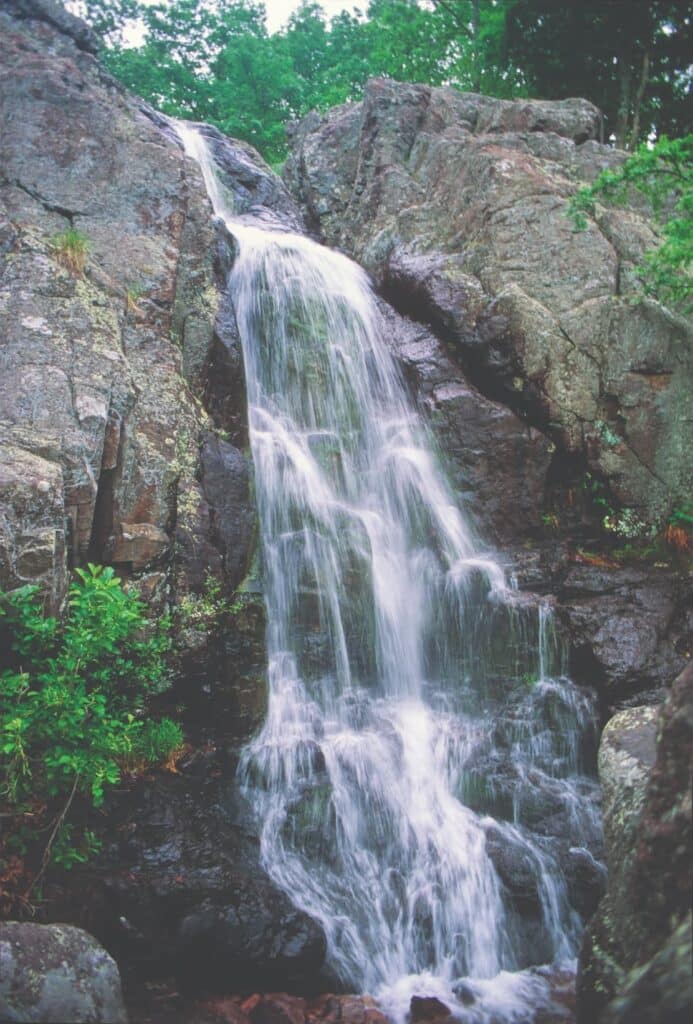
An off-trail climb from Devil’s Tollgate to open barrens on Smoke Mountain south of the creek provides a spectacular view of Wildcat Mountain with its jagged mile-long rampart around its crest. This is Devil’s Wall, thought to be evidence of a great collapsed volcanic caldera. From this vantage point, you can see why this place became a state park. In one view, you see Taum Sauk Mountain, the highest point in Missouri; Mina Sauk Falls, the tallest waterfall; Devil’s Wall high on Wildcat; and the state’s most extensive igneous barrens on Weimer Hill to the northwest. The barrens span a half-mile swatch on the southwest face of Weimer and rise nearly five hundred feet above the stream below. A thick mantle of prairie grasses and wildflowers covers the slope, here and there dotted with oaks, pines, and cedars. One of the rarest plants in the country, Mead’s milkweed, flowers in late May on this glade. Despite their small stature, many of the twisted, gnarly post oaks and eastern red cedars exceed three hundred years in age.
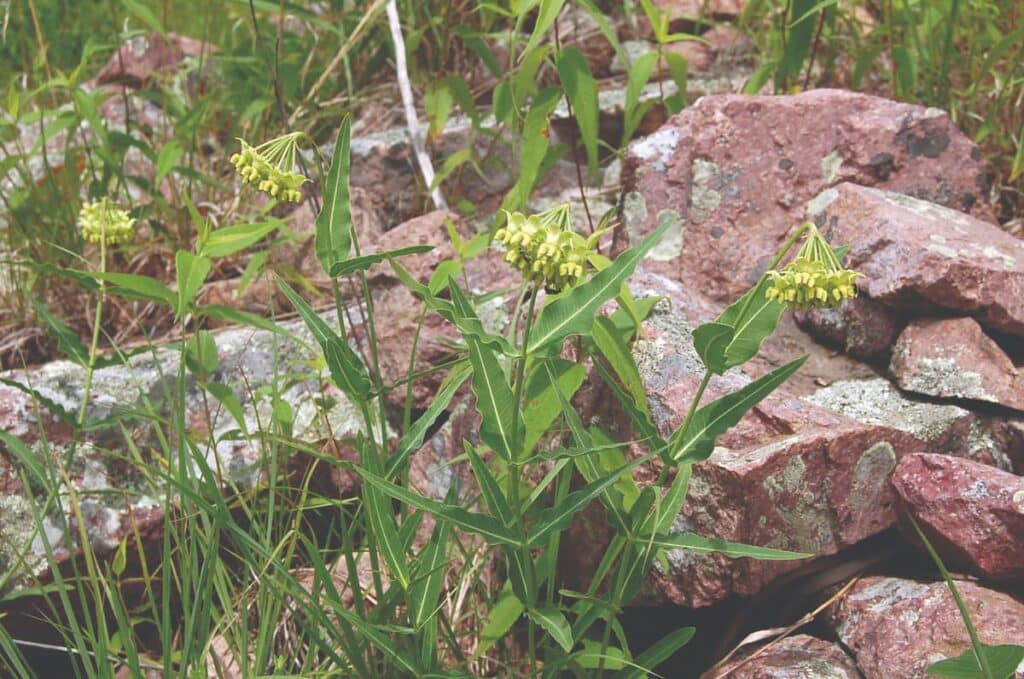
Photo by Mike Currier
Virtually the entire area seen from here and more was designated by the interagency Missouri Natural Areas Committee in 1996 as the St. Francois Mountains Natural Area, at that time by far the largest such area in the state. At 7,028 acres, it includes most of Taum Sauk Mountain State Park, Conservation Department land on Proffit Mountain, and the northeastern-most 80 acres of Johnson’s Shut-Ins, plus more than four miles of the headwaters of Taum Sauk Creek. Its unusually large size was testament to its remarkable geologic and natural integrity. It also reflected a new scientific understanding of the importance of preserving a landscape-scale mosaic of the natural communities that make this part of the Ozarks one of the greatest centers of biodiversity on the continent. State park naturalists conduct prescribed burns annually in portions of the area to mimic the natural wildfires that maintained the open woodlands and glades, which once again have ground cover rich in native legumes, grasses, sedges, and wildflowers.
Back on the trail about a mile west of Devil’s Tollgate, hikers have another choice: to continue on the Boy Scout Trail that crosses and recrosses the tree-shaded creek before going up and over Proffit Mountain to Johnson’s Shut-Ins, or to follow the Ozark Trail as it skirts the lower slopes of Weimer Hill and then ascends and traverses the long arc of Proffit Mountain through state forest and back again into Taum Sauk Park before dropping into the East Fork Black River valley and the shut-ins.
The view to the south for much of this distance along the Ozark Trail is Church Mountain, 1,300 acres of it owned by Ameren Missouri (formerly Union Electric) but leased since 1990 to the state as part of Taum Sauk Mountain State Park. In 2001 Ameren applied for federal and state permits to build a second hydroelectric storage plant with reservoirs atop Church Mountain and in Taum Sauk Creek valley, where they would be visible from nearly every vantage point and would obliterate the Boy Scout Trail along the creek. Aghast at this impending intrusion of industrial civilization into the oldest, wildest, and most ecologically diverse landscape in the state, conservationists mounted a multifaceted campaign, including preparation for legal action, intended to persuade Ameren and federal and state decision-makers that a second power plant with mountaintop and valley reservoirs in this area was simply unthinkable in the wake of the major public investment in the wild lands of this region and the heightened understanding of their extraordinary natural and cultural heritage. Much as they hoped and fought for a favorable outcome, citizen groups were astonished when Ameren within a month withdrew its permit applications, saying they had listened to the voices of the people.
Taum Sauk Mountain State Park offers unsurpassed scenery, genuine backcountry, delicate igneous barrens, an unspoiled headwaters creek, and diverse woodlands. Additional loop and connector trails are being built across Church Mountain to provide another route of access to the interior. Well-known to Scouts for more than half a century, this extraordinary mountain landscape at the geologic heart of the Ozarks continues to beckon all, whether for a hike along trails deep into the wilds or to admire and enjoy the views from roadside overlooks.
TAUM SAUK STATE PARK • 148 TAUM SAUK TRAIL, MIDDLE BROOK

Featured photo by Pat Whalen
Related Posts
Mountain’s Gonna Sing at Sam A. Baker State Park
Sam A. Baker State Park encompasses 5,323 acres of lush wilds. Whether they come for the camping, floating, fishing, hiking, or horseback riding, outdoors enthusiasts find an abundance of beauty and a nostalgic take on park hospitality.
Bison, Birds, and More at Prairie State Park
Natural prairie is the headliner at this state park, but the bison, elk, birds, and flowers are also stunning. Prairie State Park is a unique place, dedicated as a living tribute to a nearly extinguished native landscape.
The Diverse Current River State Park
The richly diverse Current River State Park has almost two miles of Current River frontage and a superb trail network. The fishing is abundant and a lazy float down the Current River is a perfect way to spend any day of the week.
Castlewood State Park
Castlewood State Park has more than thirty miles of hiking and biking trails, eleven of which are open to horseback riders. Experience the feel of a mature floodplain forest with its silver maple, box elder, black willow, white ash, sycamore, slippery elm, and hackberry. Bring a picnic and enjoy the beauty of this park.

